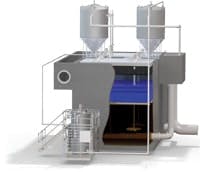Drinking water disinfection can be accomplished in a variety of ways, depending on a utility’s raw water quality and treatment objectives. Whether chlorine, ozone, ultraviolet (UV) or a combination of processes is used to meet disinfection requirements, the amount of oxidant demand in the water can impact the efficiency of disinfection, the potential for disinfection byproduct (DBP) formation and the operating costs of the process. A variety of compounds can contribute to a water’s oxidant demand, but a common source of demand lies with dissolved organic carbon (DOC).
High levels of DOC may require a higher oxidant dose to achieve a given level of disinfection. The required oxidant dose for water can be expressed as: oxidant dose (mg/L) = target oxidant residual (mg/L) + oxidant demand (mg/L).
If oxidant demand can be reduced by decreasing the DOC concentration in water prior to disinfection, the disinfectant dose can be reduced, minimizing the costs associated with operation of the disinfection process and potentially decreasing DBP formation.
There are many processes that can be used to reduce the oxidant demand associated with DOC, and these can be applied at a variety of locations in the drinking water treatment train. Achieving DOC removal in a pretreatment process can impact oxidant demand at a variety of locations throughout the plant, including preoxidation, intermediate oxidation and distribution system.
A reduction in DOC also can impact a plant’s choice of disinfectant, particularly with respect to the residual disinfectant used in the distribution system. Plants that use chloramines to reduce DBP formation may find that DOC reduction allows them to simplify their distribution system disinfection practices by switching to free chlorine for a residual disinfectant. A reduction in chlorine demand also may allow utilities to eliminate chlorine and chloramine booster stations in the distribution system.
Anion exchange pretreatment can be an effective means of DOC reduction. The MIEX process, for example, is a fluidized bed anion exchange pretreatment process utilizing a magnetic resin that can be applied to raw water sources to remove DOC. It typically is applied as the first step in a water treatment process and can achieve greater than 80% removal of DOC and UV254 absorbance. This degree of DOC removal can have a significant impact on downstream oxidant selection and demand. The Green Valley Water Treatment Plant (WTP) in California is one of a number of plants that have realized the benefits of ion exchange pretreatment and its positive impact on oxidant demand.
The Green Valley WTP has applied MIEX pretreatment for more than six years to remove DOC from its raw surface water source and reduce DBP formation. The system removes an average of 50% of the raw water DOC concentration, resulting in compliance with disinfectants/DBP regulations. The Green Valley WTP distribution system is large, with residence times of up to three weeks. Prior to the installation of the MIEX pretreatment system, high DOC concentrations created challenges with DBP formation, microbiological activity and the maintenance of a chlorine residual throughout the distribution system.
After commissioning of the 1-million-gal-per-day MIEX system, the plant’s sodium hypochlorite consumption dropped more than 43%, from an average of 42 lb per million gal to 18.2 lb per million gal. Despite this drop, the system is more easily able to maintain a chlorine residual throughout the distribution system, which also positively benefits microbiological indicators, such as heterotrophic plate count.
Estimating power consumption associated with the plant’s hypochorite generator at 2 kWh per lb of chlorine produced, the Green Valley WTP saves approximately 47.6 kWh per million gal in power use associated with chlorine generation by reducing chlorine demand, saving the plant in power costs annually.
Download: Here


